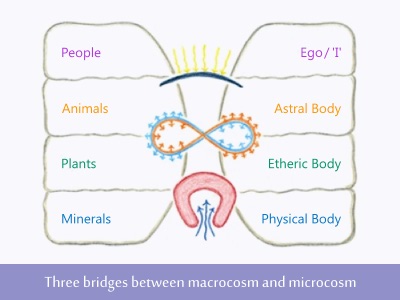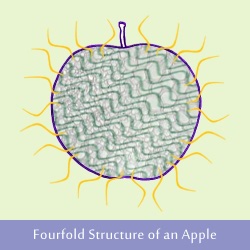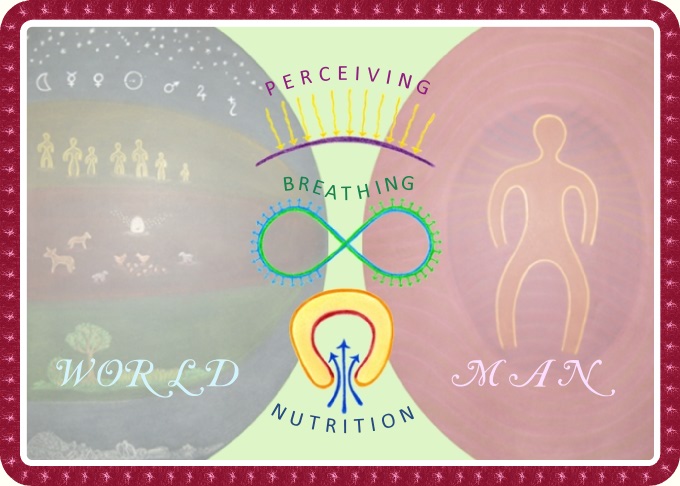Three Bridges between Man and the Outside World
If we want to understand the purpose and the role of nutrition for
human life we need to start with the simple observation that the
activity of nutrition represents one of the three fundamental ways of our
relationship to the world outside us. Each human being is connected with
the surrounding world in his waking state in three ways. "First of all,
through his senses. With the aid of his senses, he perceives and
cognizes the phenomena of the various kingdoms of Nature. But this is
not all. Man is also connected with the Earth through activities he
performs unconsciously – that is, unconsciously even while he is awake.
Man breathes, for instance, and is thus connected with the whole Earth.
The whole Earth plays into the air man takes in with his breath. In the
air he breathes, countless substances are present in a highly rarefied
condition. And the very fact that they are present in this rarefied
state enables them to exercise an influence that is of no small
importance when they are received through the breath into the organism
of man. What man perceives with his senses enters into him consciously;
but subconsciously, even during waking life a vast amount enters into
man that is more substantial than what enters him by the more tenuous
paths of perception and thought. By way of the breath man's environment
comes into him in a more material and substantial manner in comparison
with sense impressions. Nor need you
be reminded of how utterly dependent the human organism is on what it
receives in the way of earthly nourishment. So that altogether we have
to recognise three main types of influences working from the Earth upon
the awake human being." [1] These are:
1. Perceiving as Intake of Objective Sense Impressions
Through our sense organs of vision, hearing, taste, smell, touch, etc we
constantly receive a multitude of sense impressions. Sense organs should
reflect the outside world in a neutral manner, as close to the original as
possible. For example, our eyes need to be clear to get true visual impressions.
If they are for any reason dimmed, our visual perception will be distorted. This
is true for all sense organs. For that reason the archetype of perceiving can be
characterised as a mirroring of the outer world. This 'mirror' of the sense organs reflects
back to us pictures, sounds, smells, etc. If this 'mirror' is without any
deformity, then we receive objective sense impressions of the things, beings and phenomena of the world.
2. Breathing as Rhythmical Exchange between Man and the World
We are in a different relationship to the outer world with breathing – one
moment air is outside, then it is inside, and the next moment outside again. In
this process the air is partially transformed: we take oxygen from the air and
use it for our own purpose, and add carbon dioxide to the air when we exhale.
But the key feature of breathing is its rhythm of
inhalation and exhalation which goes on throughout our life. For that reason the
archetype of breathing can be characterised as a rhythmical interchange of air
between man and the outside world.
3. Nutrition as Total Metamorphosis of Outer Substances
Through eating and drinking we take in outer substances on a daily basis. If
one consumes on average 1.2 kg of food per day, in 70 years the combined amount
comes to over 30 tons. This great amount indicates the importance of nutrition
for human life on the earth. Even more important is the fact that we do not simply use
substances from the outside world as they are – all substances are subjected to
radical transformation before they can be used for the manifold needs of our
organism. For that reason the archetype of nutrition can be characterised as the
taking in and metamorphosis of outer substances
to such a degree that they can serve the specific needs of the human being.
Creation of an Inner Space for Activities of Nutrition
There is another important characteristic of human nutrition beside the one
described above. If we want to grasp it we need to observe the transition
from a plant's assimilation of nutrients to those of lower animals. "If we
consider the green leaf of a plant, we know that the process of
photosynthesis is carried on in this leaf in such a way that light streams
in from above and carbon dioxide enters from below the leaf. The third
process is the in-flowing stream of water and mineral salts which is taken
up by the roots." [2] We can compare:
- our first bridge to the outside world, the inflow of sense
impression, with the light streaming into leaves;
- our second bridge, breathing, with a plant's assimilation of carbon dioxide
and release of oxygen;
- and our third bridge, nutrition, with the stream of a plant's sap
carrying upwards dissolved mineral substances provided by the mineral crust
of the Earth.
The combined effect of these three activities in a plant
culminates in production of carbohydrates in its leaves, and proteins
and fats in its seeds. In this manner a plant is capable of creating all
three basic substances of our food which enable our life. [3]
Now "imagine that we change the leaf out of a flat structure into
a kind of round sphere (see picture, left side). The upper side is the realm where the
light from out of space streams in; the other side is the dark side where
the carbon dioxide nourishes the leaf." [4] To this we
need to add mineral salts coming from bellow, from the earth. In fact, we
can already observe change from the plane to the sphere when we compare
leaves with seeds. But we can never say that any kind of digestive process goes on
inside the plant. For a plant doesn't have
something we could call an inner space. For this something else needs to
happen in the evolution of animal. "If
this archetypal picture of plant process (of assimilation of nutrients)
alters in such a way that animal or man starts to develop, then we find that
the lower part is invaginated. It becomes invaginated like a ball which has
been squashed in, and we see the formation which is commonly called the
gastrula. We have now gone from the round sphere of the leaf to the
archetypal form of a simple animal (see picture, right side). On the upper side
sensory processes arise, and in the lower, invaginated part, digestion and
nutrition processes begin. Thus we have made the step from the plant to the
animal." [5]

This process which includes folding inwards of the spherical form is
called gastrulation, which "is a phase early in the embryonic development of
most animals." [6] In the case of human beings it happens "around day 16
after fertilisation". [7] Thus we can see that in the case of animals and
human beings the inner space
is created in the organism where the processes
of digestion and metamorphoses of nutritional substances are performed in
relative independence from the outer world. In the case of lower animals
these processes are still quite simple and still quite open to the
influences from outside world. When we progress up towards higher animal
forms, we see progressively more inward, more independent
and more complex processes of nutrition – all happening in this inner space
that has been created in the evolution of animal kingdom to which
also our physical body belongs.
Fourfold Nature of Real Foods
In FOURFOLD HUMAN BEING
it is explained that the human being consists of four bodies, each providing us with specific functions:
- Physical body reveals the inner forms and structures [8]
- Etheric body enables our life functions
- Astral body enables us to sense and feel
- Ego or 'I' enables us to think and be self-conscious
This human microcosm is connected by means of three bridges – sense impressions, breathing, and nutrition –
with the outer world, the macrocosm consisting of four kingdoms: the
mineral kingdom, the plant kingdom, the animal kingdom, and the human kingdom. [9]

In FOURFOLD HUMAN BEING
it is also explained that other natural kingdoms –
with the exception of minerals [10] – consist of more than just a physical
body. Because our food comes mainly from the plant and animal kingdom, this
means that food we eat also contain etheric and astral components. This is
not only the case with food of animal origin but also with food of
plant origin. "It is true that the plant as it stands there in
the ground has only a physical and an etheric body, and does not contain an
astral body as the animal does; nevertheless, the astrality must outwardly
surround the plant on all sides. The plant would not bloom if the astrality
did not touch it from outside. Plants do not internalize astrality the way
animals and human beings do, but they do need to be touched by it from
outside. Astrality is everywhere, and nitrogen, the carrier of astrality,
is also everywhere. So you can also imagine how important nitrogen must be
for the life of plants." [11]
Although plant proteins are formed in its upper part, mainly in their
seeds, all parts of plant contain small amounts of protein. This means that
in all vegetables and fruits we also have small amounts of 'plant-like
astrality' (in comparison with astrality present in animal food). There is
more of this plant-like astrality in plant seeds (e.g. beans, nuts, edible
seeds, and grains) due to their greater quantity of protein.
What about the presence of ego forces in
the animal and plant kingdoms? Whilst our ego enables us to be
self-conscious, in the case of animals and plants ego forces work
differently. They provide a specific form which fundamentally determinates
the whole life of a single plant or animal species. The outer form also
provides a quick way to distinguish one species from another (e.g., a sheep
from a goat, barley from oats, etc.). This function of ego-organization is evident also in the case of human
beings. Whilst we share the general form of the human being which enables us
to distinguish a human being from a monkey, we have also developed
individual features to such a degree that we can recognise each other by the
outward appearance. Therefore we can recognize the activities of ego
organization in the animal and plant kingdoms in the emergence of a
multitude of species, each with its own typical outward form.
Now we can look at one example of the fourfold nature of food – an apple:

The mineral part (grey) provides its inner structure,
the texture of food. Then we have etheric forces (green), permeating all
fluids with the energy of life.
[12] Astral forces (yellow) are outwardly manifested in the food's
taste, colour, and aroma. Its individual aspect
(violet) is manifested in its outer form which enables us to distinguish an
apple from a pear even if we see just a simple child's drawing of them.
Thus we can recognise the fourfold nature of foods coming from the plant
and animal kingdom which are the two main sources of our food.

For complementary perspectives see:
♦ NUTRITION FOR BODY & SOUL
♦ NUTRITION - HEALING - EDUCATION
DIETARY CONCLUSIONS & PRACTICAL INSTRUCTIONS
The great significance of nutrition can be recognised merely by
observing the relationships to the other kingdoms of nature presented in
this text. For many people it is an obvious fact that nutrition plays an
important part in human life, but the significance of nutrition is much
greater than is usually thought. Nutrition has many purposes and is related to various
activities performed by human beings. For that very reason it is
sensible to take the question of nutrition very seriously – much more
seriously than is common nowadays even among more educated and
enlightened people.
One needs to be aware that food has short-term effects, medium-term
effects, and long-term effects. While we can investigate some short-term and
medium-term effects, it is much harder to investigate long-term effects
which sometimes manifest only after three or four decades, or even after
longer time span.
[13] These long-term effects can be investigated by
statistical comparison of the health impacts on two groups of people eating
different type of diets. However, this can be done only to a limited extent;
there are simply too many influences on the state of human health for such
investigations to be conclusive. Besides the length of statistical
observation which needs a few decades to get one or two useful dietary
guidelines put great limits to such research.
For that reason it is sensible to take a preventative approach and
invest more time and money into what we put into our bodies on a daily
basis. This is even more in need when we understand that the quality of what
we eat depends on the more hidden quality of life forces in the food, and on the quality of
forces which manifest in the taste and aroma of food. For that reason it
is more than urgent to overcome materialistic simplification which states
that we are affected only by physical substances present in our food and
their chemical composition.
For the sake of this we need to develop a new understanding of the true
nature of the human being and the role of nutrition – that is, a holistic
understanding of our constitution and fundamental nutritional principles. Otherwise we can fall into all kinds of
self-deceptions and illusions. But with the help of a new understanding
of nutrition we can arrange our lives in such a way that "the food we
eat will not hinder us from achieving the full potential of what we, as
human beings, ought to be." [14]
WARNING: You always have to put the above
practical dietary instructions inside the framework of
GENERAL NUTRITIONAL
GUIDELINES with the aim to know their limits when looking for a solution
of a specific nutritional problem. You also need to be familiar with
THE ROLE OF NUTRITIONAL GUIDELINES
with the aim to avoid any one-sided conclusions.





